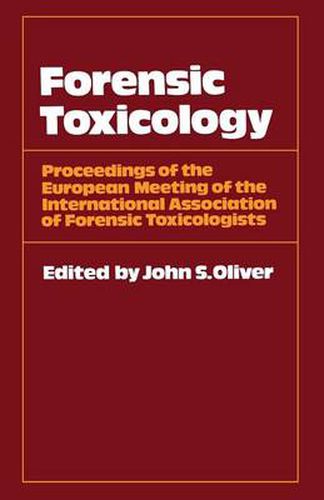Readings Newsletter
Become a Readings Member to make your shopping experience even easier.
Sign in or sign up for free!
You’re not far away from qualifying for FREE standard shipping within Australia
You’ve qualified for FREE standard shipping within Australia
The cart is loading…






This title is printed to order. This book may have been self-published. If so, we cannot guarantee the quality of the content. In the main most books will have gone through the editing process however some may not. We therefore suggest that you be aware of this before ordering this book. If in doubt check either the author or publisher’s details as we are unable to accept any returns unless they are faulty. Please contact us if you have any questions.
Forensic toxicology has progressed rapidly and diversified greatly in recent years. The members of the International Association of Forensic Toxicologists provide a valuable service through the association’s bulletin. In its pages members hear of new poisons as they are encountered and the analytical techniques used to deal with them. There is a wealth of information in the form of case reports which is used to assist with the interpretation of the results. Each year the members have the opportunity of meeting in Europe. In 1979 the chosen venue was the University of Glasgow and the meeting was hosted by the Department of Forensic Medicine and Science. The department was established by Royal Charter in 1839 within a few years of the beginning of the modern approach to toxicology. In those early years the function of the department was to teach forensic medicine and toxicology. Today the department has become a recognised centre for the teaching of forensic medicine. The toxicology section has expanded greatly to provide the best forensic and environmental toxicology in Scotland. Inorganic analytical facilities are available for the investigation of metallic poisons by atomic absorption spectrometry, neutron activation analysis, X-ray fluorescence and anodic stripping voltametry. Organic analytical toxicology is pursued using gas chromatography, high performance liquid chromatography, immunoassays, and gas chromatography mass spectrometry. Apart from the normal research and routine investigations of a toxicological laboratory the department specialises in the investigation of fire related deaths, solvent abuse (glue sniffing) and trace element studies in human subjects.
$9.00 standard shipping within Australia
FREE standard shipping within Australia for orders over $100.00
Express & International shipping calculated at checkout
This title is printed to order. This book may have been self-published. If so, we cannot guarantee the quality of the content. In the main most books will have gone through the editing process however some may not. We therefore suggest that you be aware of this before ordering this book. If in doubt check either the author or publisher’s details as we are unable to accept any returns unless they are faulty. Please contact us if you have any questions.
Forensic toxicology has progressed rapidly and diversified greatly in recent years. The members of the International Association of Forensic Toxicologists provide a valuable service through the association’s bulletin. In its pages members hear of new poisons as they are encountered and the analytical techniques used to deal with them. There is a wealth of information in the form of case reports which is used to assist with the interpretation of the results. Each year the members have the opportunity of meeting in Europe. In 1979 the chosen venue was the University of Glasgow and the meeting was hosted by the Department of Forensic Medicine and Science. The department was established by Royal Charter in 1839 within a few years of the beginning of the modern approach to toxicology. In those early years the function of the department was to teach forensic medicine and toxicology. Today the department has become a recognised centre for the teaching of forensic medicine. The toxicology section has expanded greatly to provide the best forensic and environmental toxicology in Scotland. Inorganic analytical facilities are available for the investigation of metallic poisons by atomic absorption spectrometry, neutron activation analysis, X-ray fluorescence and anodic stripping voltametry. Organic analytical toxicology is pursued using gas chromatography, high performance liquid chromatography, immunoassays, and gas chromatography mass spectrometry. Apart from the normal research and routine investigations of a toxicological laboratory the department specialises in the investigation of fire related deaths, solvent abuse (glue sniffing) and trace element studies in human subjects.